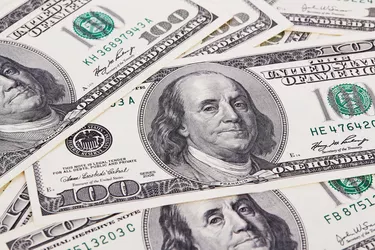
When you write the word "cash" on the payee line of a check, you're making the check payable to anyone who has possession of it. The account holder has no control over the situation if the check is lost or stolen, so financial institutions strongly recommend against doing so unless as a last resort. But you might find yourself in a situation where you think the benefits outweigh the risks.
Why Would You Write a Check Out to Cash?
Video of the Day
You might urgently need cash for some reason, and you've left your debit card at home or you can't find an ATM. You do have your checkbook or a personal check with you, however. You can write it to "cash" and take it to the nearest check-cashing service in exchange for cold, hard dollars.
Video of the Day
Or maybe you want to transfer money from your checking account to your savings account ASAP. You can go to your bank's branch, make a check payable to cash, endorse it and deposit it into your savings account.
Reasons for Wanting an Unknown Payee
Huntington National Bank points out that you might also want to make payment to an individual or a company whose legal name you're not sure of. You have the option of leaving the payee line blank in this case so the recipient can write their own name in, or you can make out the check to "cash." The end result is the same. The check is payable to whomever has possession of it.
How to Write a Check Payable to Cash
You can simply write that single word – "cash" – on the line of the check that reads, "Pay to the order of." You would normally enter the name of the individual or business you're paying here. Nothing changes with any of the other areas of the check. You would enter all the information that's always required:
- the date on the line provided at the upper right corner
- the amount of the check in numerical form in the box to the right of the "Pay to the order of…" line
- the amount of the check spelled out in words on the line beneath the "Pay to the order of…" line
- your signature on the line provided on the bottom right corner
You also have the option of making note of what the payment is for on the "memo" line to the left of the signature line.
Will a Bank Deposit a Check Made Out to Cash?
Most financial institutions aren't happy about being presented with a check made out to cash because there's always the risk that the individual cashing or depositing it isn't the check writer's intended payee. First Quarter Finance indicates that a bank may refuse to cash the check, or they might put a hold on the funds if you deposit it.
The hold would remain in place until the issuing bank honors the check and it's clear that fraud is not involved. The process will probably go more smoothly if you take the check to your own bank and a branch where the bank teller knows you.
How to Deposit a Check Made Out to Cash
The deposit process is the same whether you're depositing a check made out to you or one that's been made payable to cash.
- Endorse the check on the back. Turn it over and endorse it in the proper area on the back of the check.
- Look for two lines. You should see one of two lines there, appearing at the left side. The check might even be printed with the words "endorse here," according to Huntington National Bank. But it doesn't matter if the words or lines aren't included.
- Include the necessary information. Write "for deposit only" and your account number on one line.
- Provide your signature. Sign your name on another line.
Frequently Asked Check Questions
Some FAQs about writing checks made out to cash include:
Can I Write a Cashier’s Check Out to Cash?
There's no law in place that prohibits a bank or other financial institution from issuing or approving any type of check that's made out to cash, including a cashier's check, according to BankersOnline. But there's no rule that says they must do so either. It's possible that your bank might refuse.
What Are My Alternatives to Writing a Check Out to Cash?
You can always write the check to yourself as the payee. Then simply endorse the back with your name when you're ready to give the check to the recipient. But banks and credit unions might not be eager to cash or deposit these checks either.
You might also use your bank's mobile app or your online banking app if your intention is to transfer funds from one of your bank accounts to another. You'll spare yourself a trip to the bank as well.